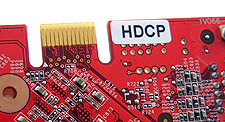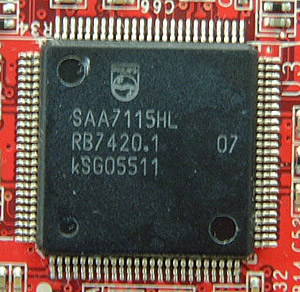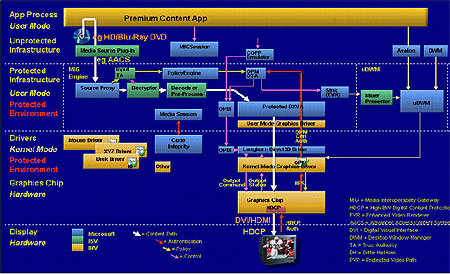
|
The videocard supports a whole
host of TV output options including S-Video, Composite, Component output (Y, Pb, Pr) and the NX7900GT-VT2D256E-HD is also HDMI compatible if a DVI-to-HDMI cable is used.
88% Rating: 
|
|
|
|
Home >
Reviews >
Video Cards >
MSI NX7900GT-VT256E-HD |
|
|
Inside Mechanics of HDCP Technology
 High bandwidth Digital Content Protection (aka HDCP) is
a form of digital rights management developed by Intel for digital and audio content
which is intended to travel through the DVI port or High Definition Multimedia Interface
(HDMI). HDCP has been spearheaded the movie industry in an effort to fight piracy. The standard was developed for the home theatre market first, for the purpose of ensuring that digital high definition content could not be successfully captured and copied between the high definition receiver and the television set or monitor that displays the signal. High bandwidth Digital Content Protection (aka HDCP) is
a form of digital rights management developed by Intel for digital and audio content
which is intended to travel through the DVI port or High Definition Multimedia Interface
(HDMI). HDCP has been spearheaded the movie industry in an effort to fight piracy. The standard was developed for the home theatre market first, for the purpose of ensuring that digital high definition content could not be successfully captured and copied between the high definition receiver and the television set or monitor that displays the signal.
You should also note that this means you will have more components to
upgrade as your videocard and monitor must be HDCP compatible in order to
view high definition content as it's intended. Should one or more components not
be HDCP compatible content is downgraded to DVD quality.
Since HDCP is a new technology, we're going to
spend the next couple pages looking at how it works, what technologies are
involved and the limitations it will impose if some hardware is non-compliant.
If you would like to jump right to the overclocking and gaming benchmarks for
the MSI NX7900GT-VT2D256E-HD videocard you can find them here.
The Mechanics of High Definition Content
Protection and Output Content Protection Management
 Microsoft, as you might imagine, intends to support HD DVD and video on
all its current operating systems and particularly in Windows Vista. To
this end, the company is building support for HDCP into the operating system as
part of its suite of DRM (Digital Rights Management) abilities called Output
Content Protection Management (OCPM). Microsoft, as you might imagine, intends to support HD DVD and video on
all its current operating systems and particularly in Windows Vista. To
this end, the company is building support for HDCP into the operating system as
part of its suite of DRM (Digital Rights Management) abilities called Output
Content Protection Management (OCPM).
Microsoft's OCPM suite, part
of the Windows Vista, comprises several video and audio encrypting
functions with the stated aim of allowing content providers to trust the PC as a
medium for playing their products without fears of illegal copying. Protecting copyrighted 'premium
content' will be accomplished both by confirming an 'approved state' for each
computer, free of potentially piracy-enabling software and hardware, and by
encrypting certain types of media as they make their way through the computer.
Using the same principle as VPNs passing encrypted information over
the Internet, a portion of OCMP
will ensure that the data from a HD DVD or other media storage device (BlueRay for
example) is encrypted as it passes between the source and the monitor/TV. Even if
the encrypted data is captured, it cannot be used.
Obviously, in the current marketplace it's much easier for hardware and
content providers to co-ordinate protective measures on home theatre devices which
are non-customizable. The almost infinite variability of the PC has made it the centerpiece
of media piracy and forced music and video publishers into elaborate
and unsuccessful attempts to restrict user's abilities to copy their media.
Protected Video Path Output Protection Management or
PVP-OPM
HDCP breaks down into two major components, video and audio protection. PVP OPM or Protected Video Path Output Protection Management is a component of Microsoft's OCPM. PVP OPM has drawn the most flak from industry insiders and consumers alike since this is the component which require new videocard/monitors or TVs.

A series of identifying checks will be
performed on the drivers and the hardware at startup to verify that they are
approved to operate under PVP-OPM. This establishes a 'safe state' for protected
content to be played. If this state is not reached, attempts
to play protected media over DVI or TV-output will result in either failure or a
reduced quality image.
For the purposes of
PVP-OPM, component outputs will always be either disabled or have their signals constricted.
This is sure to displease owners of previous generation ATI and nVidia video
cards which feature component outputs for HDTV but are not HDCP compliant.
|
